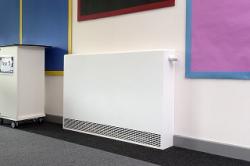JAGA - WHAT ARE LOW SURFACE TEMPERATURE RADIATORS?
June 2019
 Low surface temperature (LST) radiators are a safer alternative to traditional radiators, and are well suited to all kinds of healthcare buildings, residential accommodation, schools and nurseries.
Low surface temperature (LST) radiators are a safer alternative to traditional radiators, and are well suited to all kinds of healthcare buildings, residential accommodation, schools and nurseries.
WHY ARE LST RADIATORS A SAFER ALTERNATIVE?
At the top-end of their operating range, the casing of a steel panel radiator might reach a temperature of 80 deg.C. That’s enough to cause potentially severe burns to anybody who touches it for more than a few seconds – and even partial burns are possible with the briefest of contact.
The heating element and pipework in an LST radiator are decoupled from the casing, so no part of the surface exceeds 43 deg.C. Staying cool-to-touch, even in the event of thermostat failure, means LST radiators meet safety standards for healthcare and education environments, protecting children, the elderly and other vulnerable people.
A traditional radiator can be ‘converted’ to LST through the use of guarding. But, while the guarding is safe to touch, it acts as a barrier to heat transmission and becomes less efficient. LST radiators are a full safety offering – often featuring all of their pipework hidden inside the casing – without compromising performance. An LST radiator is also defined by more than just temperature. Other safety features – like rounded corners and chamfered edges, compared to the sharp edges of other radiator designs – protect anybody who might fall onto or collide with the radiator, reducing the likelihood of physical injury
WHAT OTHER FEATURES CAN LST RADIATORS OFFER?
Although not part of what defines a radiator as ‘LST’, a common feature is a heating element/coil – like Jaga’s Low H2O technology – that uses only a fraction of the water of a steel panel radiator.
The reduced water volume – around 10% of the volume in a standard steel panel radiator – means the radiator warms up and cools down faster. Building occupants have easier and better control over maintaining comfortable room temperatures, as the effect of a change is felt sooner, rather than waiting for an extended period in an uncomfortably hot or cold environment.
A faster thermal response places less demand on the heating source, whether a boiler or a heat pump. By not having to work as hard, fuel and energy consumption is reduced, leading to greater efficiency and reduced carbon dioxide emissions.
LST OPTIONS FOR DIFFERENT APPLICATIONS
Again, while not part of what makes an LST radiator specifically, the casing design of a radiator has an influence on performance.
Jaga use aluminium or copper for some of the range, which also contributes to faster thermal response. However, steel remains an option, especially for buildings such as schools and hospitals. These dynamic environments present particular challenges where the safety features of an LST radiator need to be combined with a robust design.
Jaga offer a comprehensive range of low surface temperature (LST) and cool-to-touch radiators for use in residential, healthcare and educational buildings. To find out more about Jaga’s energy efficient heating technology and solutions, call 01531 631533 or visit https://www.jaga.co.uk/.